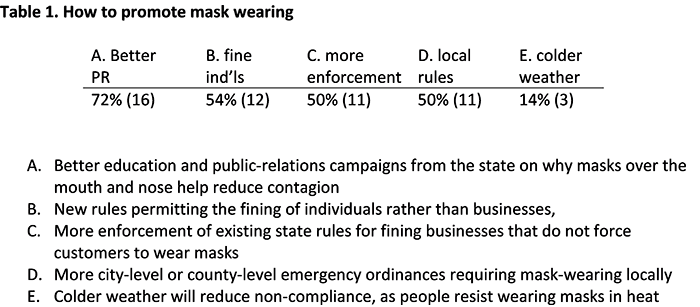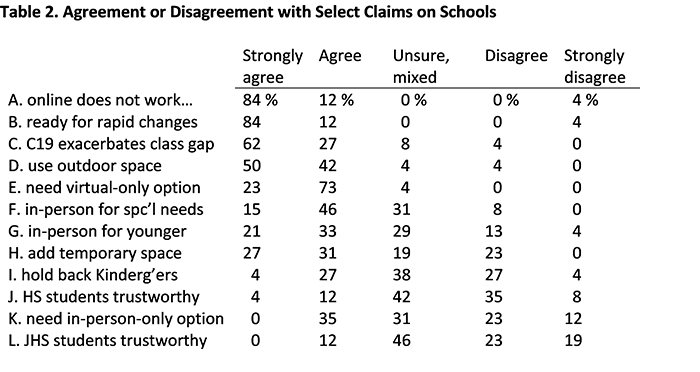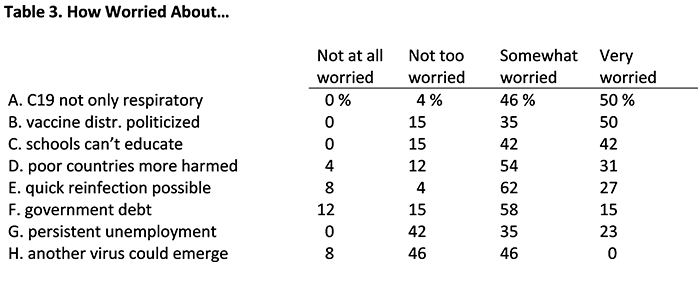
IGPA is developing several Pandemic Stress Indicators, designed to evaluate the social and economic effects of the COVID-19 pandemic on Illinois residents. The Pandemic Stress Indicators grew out of the work on IGPA’s Task Force on the Impact of the COVID-19 Pandemic.
This first stress indicator is a frequent poll of three sets of experts about pandemic policies. Experts on economics, public health, and/or vulnerable populations from across Illinois have generously agreed to provide regular opinions on various pandemic policies. The panelists, with affiliations, are listed in the full report. In answering the surveys, all panelists provide only their own personal views and do not offer official positions on behalf of their respective institutions.
Our fifth survey was launched on July 15, and we received 26 responses between July 15 and July 19.
Since July 2, when we launched the fourth survey, statistics on the pandemic in the U.S. have mainly gotten worse. In Illinois, there has been a marked increase in cases and an uptick in positivity (proportion of tests that come back positive for infection) and hospitalization rates for those testing positive. Even deaths, which is a lagged indicator of disease spread, may be showing a small rise.[1] We noted that the conditions were changing, and asked respondents to evaluate some of the Phase 4 rules, many of which we had also asked about in the prior survey. Here is how the assessments, a couple of weeks apart, compare.

Exact question wordings differed slightly by wave, and are reproduced in the appendix. Because of non-responses, row percentages are based on slightly different totals: 23-25 for wave 4 and 25-26 for wave 5, with 19 having completed both waves.
In every case, the overall shift has been away from seeing openings as “sensible,” toward regarding Phase 4 allowances as “not restrictive enough.” Only hair care (“allow hair-care facilities to open, with masks, customer distance, and total-customer caps”) and child-care (“allow child care and summer programs to open with temperature checks, masks (except for infants), and capacity caps”) commanded majority support as sensible rules.
That attitude towards hair care, as opposed to cinemas, restaurants, and places of worship, suggests that it is crowding that the experts fear. Being outdoors might make an activity safer, but even summer youth sports (e.g. baseball or soccer) tend to involve some close contact and are not easily compatible with wearing masks. The 19 respondents who completed both of the wave-4 and wave-5 surveys were mostly consistent in responses, but most, not all, of the shifts were from “sensible” to “not restrictive enough.” Nobody in either wave saw any of the rules as too restrictive under current conditions.
Support for allowing K-12 schools to be open was split in that item, but that rule is largely not being implemented at the moment due to summer break. Looking ahead to school re-opening, we also asked about a number of claims or arguments being made about how best to get schooling back under way. For each of 12 claims, respondents could agree or disagree, strongly, or not, declare themselves unsure, or skip the item. Table 2 shows the items, with shorthand labels, roughly in order of agreement level.

Ns: 24 (G); 25 (A, B); 26 (others)
Exact Wordings:
A. Online education does not work as well as in-person schooling for most children.
B. However schools start the fall, they must be ready to make rapid changes in instructional modes if problems arise.
C. The pandemic's disruption of schooling is going to increase wealth and class differences in educational opportunities and school quality.
D. Schools should prioritize using outdoor space for some instruction while weather permits.
E. Parents must have the option to choose virtual-only attendance for their children.
F. Priority for in-person schooling should go to families with lower incomes and students with special educational needs.
G. Priority for in-person schooling should go to younger children.
H. School districts should find ways to add temporary instructional space, wherever possible, by whatever means.
I. Parents with children due to start kindergarten should hold them back a year if they can manage it.
J. High school students can be trusted to behave responsibly by wearing masks, keeping distance, washing frequently, etc.
K. Parents must have the option to choose in-person schooling for their children.
L. Middle school or junior high school students can be trusted to behave responsibly by wearing masks, keeping distance, washing frequently, etc.
Most of the claims generated more agreement than disagreement. Exceptions were the stipulations that high school students or, especially, junior-high-school (middle-school) students can be trusted to behave responsibly, by wearing masks, washing regularly, and so on. The claim that “parents must have the option to choose in-person schooling for their children” won no strong agreement, but 35 percent agreed, so there was rough symmetry, except that about a third of the disagreement was “strong.” The argument that parents should hold kindergartners back a year saw exactly symmetrical responses.
The other items, with which most agree, do not neatly add up to a plan for schooling, as such. There are practical, logistical and weather difficulties with schools adding new, temporary space and using outdoor instruction, not to mention on-the-fly adjustments as the school year progresses and pandemic conditions shift.
Prioritizing in-person schooling for young children, children with special needs and children from low-income families drew support, but for school administrators, how to provide safe in-person instruction is at least as hard a problem as who should get it first.
But the near consensus that “Online education does not work as well as in-person schooling for most children” points away from an everything-online path. (Our panel consists of experts in economics, public health, and vulnerable populations, and only a few make a professional study of schooling or education to any degree.)
Our survey also asked respondents to describe how worried they are about a small battery of claims about the pandemic. Table 3 orders these items, which were ordered randomly in the questionnaire, by overall worriedness.

N=26
Exact wordings:
A. It has become clear that Covid-19 is not merely a respiratory ailment, but a much more dangerous virus, with numerous bad effects on the body.
B. When there is finally a vaccine for Covid-19, its distribution will not be guided by medical logic or equity concerns, but by power politics.
C. Schools will not be able to deliver quality education until there is a vaccine.
D. Poorer countries will ultimately be much more badly harmed by Covid-19 than the US, Europe, or even China.
E. Mounting evidence suggests that quick reinfection and/or reactivation of Covid-19 for recovered patients is possible.
F. Governments at all levels are accruing huge levels of debt because of the pandemic.
G. Long spells of unemployment may render many Americans unemployable.
H. Another novel deadly virus could throw the world back into shutdown before we recover from Covid-19.
It is somewhat striking that many months into this crisis, the most worrying claim concerns the nature of the virus itself. It is difficult to do cost-benefit analysis when there is large uncertainty surrounding the possible outcomes. Because the SARS-Cov-2 virus that causes COVID-19 has been shown to have more and worse effects than was first appreciated, it is not surprising that views of best practices and policies have also shifted. This form of question does not distinguish between disbelief and nonchalance: one can be not worried because one has doubts about the claim, or because the claim, though, correct, is not worrying. But with 85% on the “worried” side, these experts seem genuinely anxious about eventual vaccine distribution.
We again asked respondents to forecast the state’s condition by the end of 2020. As the survey was being launched, the governor’s office announced a major revision of the Restore Illinois plan. The new scheme employs 11 regions, not four, and modifies criteria that define the thresholds between phases. With that important caveat, Table 4 shows our experts’ expectations for the end of 2020 under the prior scheme.

N=24 except for N-C where N=21 (we exclude those unsure or unwilling to guess from the calculated percentages above)
In brief, no one was optimistic enough to predict improvement (to Phase 5), and the expectations were, by and large, more pessimistic than in prior surveys of this panel. For three of the four regions, the most popular answer was a slip back to Phase 3 (in the case of the North-Central region, that choice was tied with the status quo of Phase 4). At least two experts foresaw a regression all the way back to Phase 1 for each region.
Many respondents were generous enough with their time to elaborate on their prior answers, in short essays. Multiple respondents mentioned varieties of vicious cycles, as unemployment cascades into worse education, mental health, and life chances, while employers aiming to become “contactless” steadily reduce demand for workers. In turn, those with lower incomes and fewer opportunities at the outset of the crisis can be hit much harder, for longer. Others made similar points about the importance of schooling, especially for the most needy. We await, with trepidation, evidence of the effects not only on children’s learning but on their socialization and mental health of their extensive, widespread isolation.
Still others stressed that the economic slowdown is very likely to be a long-term phenomenon, with deep impacts, perhaps especially on the least well off, yet again.
Yet another concern was excessive polarization over policy and the normalization of anti-science rhetoric. Some fret that the United States has badly compromised its standing with the rest of the world, and that Americans will feel repercussions in many ways for a long time.
On the medical front, several respondents emphasized that this virus remains not well understood and that the likelihood of a very long crisis is far higher than generally realized.
With so much (justified) gloom, we also asked if there have been any upsides that offset, to some degree, all the worries and setbacks. No one seemed to take offense at that query, and multiple respondents mentioned families having more time together, and some rebalancing of priorities. One respondent was impressed by “fabulous female leaders in other countries” who have steered their countries to better outcomes. In the category of “small blessings,” one respondent predicted a better-than-usual flu season in the upcoming fall and winter.
Appendix: Exact Question Wordings
Sensible Rules?
Wave 5 (July 15)
Since our last survey, two weeks ago, Illinois has seen increases in confirmed cases and positivity rates. Central Illinois has seen an increase in the percentage of confirmed cases resulting in hospitalization. In light of such changing data, we would like your opinions, again, on some of the Phase 4 regulations.
Response options for each row were: “too restrictive”; “sensible”; and “not restrictive enough”. Non-response was also permitted.
| Allow gatherings of 50 or fewer. |
| Allow youth sports, with venue capacity limits. |
| Allow indoor dining at restaurants, with distance and caps on party size and total capacity. |
| Allow hair-care facilities to open, with masks, customer distance, and total-customer caps. |
| Allow cinemas and theaters to open, with 50-guest caps, and concession regulations. |
| Allow child care and summer programs to open with temperature checks, masks (except for infants), and capacity caps. |
| Allow indoor worship services, with guidance (not restrictions) on capacity, cleaning, and conduct. |
| Allow gyms and fitness clubs to open, with distance rules and 50-guest caps. |
| Allow K-12 schools to re-open, under guidelines, and with district discretion over details. |
Wave 4 (July 1)
Below are some of the revised restrictions on life now in place for Phase 4. How would you characterize each rule? If you are not sure what to think about a given rule, you can leave a row blank.
Response options for each row were: “too restrictive”; “sensible”; and “not restrictive enough”. Non-response was also permitted.
Gatherings of 50 or fewer allowed
P-12, higher education, preschool open, with safety guidance
Bars and restaurants open, with capacity limits and safety guidance
Health and fitness facilities open, with capacity limits and safety guidance
Theaters open, with capacity limits and safety guidance
Indoor worship services permitted, with safety guidance
As summer moves along, school district are announcing plans for the autumn term. Thinking about K-12 education, please indicate how you react to the following claims.
Response options were: “strongly agree”; “agree”; “unsure, mixed feelings”; “disagree”; “strongly disagree”; and non-response.
Online education does not work as well as in-person schooling for most children.
However schools start the fall, they must be ready to make rapid changes in instructional modes if problems arise.
Parents must have the option to choose virtual-only attendance for their children.
Schools should prioritize using outdoor space for some instruction while weather permits.
The pandemic's disruption of schooling is going to increase wealth and class differences in educational opportunities and school quality.
Parents with children due to start kindergarten should hold them back a year if they can manage it.
High school students can be trusted to behave responsibly by wearing masks, keeping distance, washing frequently, etc.
School districts should find ways to add temporary instructional space, wherever possible, by whatever means.
Priority for in-person schooling should go to families with lower incomes and students with special educational needs.
Priority for in-person schooling should go to younger children.
Parents must have the option to choose in-person schooling for their children.
Middle school or junior high school students can be trusted to behave responsibly by wearing masks, keeping distance, washing frequently, etc.
Worries
Here are a set of claims that are often mentioned in discussions of what are the major effects of this pandemic and what policies are working or not. Please indicate how worried you feel, personally, about each. You may skip any row if the item is too unfamiliar or otherwise hard to evaluate.
(Exact claims reproduced below the table.)
What is your biggest worry about long-term effects of the pandemic and resulting shutdown? Are there any upsides that offset, to some (small) degree, the big problems?
(open-ended essay box)
Forecast
Finally, we will ask you once again, to forecast, based on present data and trends, how you think the four regions of the state, as defined by Restore Illinois, will look on December 31, 2020, (As always, you can skip a row if you are not comfortable making a prediction for that area.)
[1] The increase in total cases is plain in daily data reported at https://www.dph.illinois.gov/covid19/covid19-statistics. Total reported deaths, retrieved from the same site, might or might not display an upward trend, depending on the statistical model fit (e.g. contrast third- and fourth-order polynomials, applied separately to each time series for the seven days of the week). Data and figures for positivity and hospitalization can be found at https://www.dph.illinois.gov/restore. Recent trends vary by region.
Online education does not work as well as in-person schooling for most children.